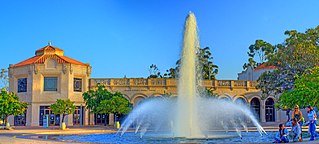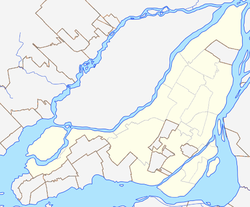
The Montreal Biodome is a facility located at Olympic Park in the Mercier–Hochelaga-Maisonneuve neighbourhood of Montreal, Quebec, Canada, that allows visitors to walk through replicas of four ecosystems found in the Americas. The building was originally constructed for the 1976 Olympic Games as a velodrome with 2,600 seats. It hosted both track cycling and judo events. Renovations on the building began in 1989 and in 1992 the indoor nature exhibit was opened.
The Oregon Museum of Science and Industry is a science and technology museum in Portland, Oregon, United States. It contains three auditoriums, including a large-screen theatre, planetarium, and exhibition halls with a variety of hands-on permanent exhibits focused on natural sciences, industry, and technology. Transient exhibits span a wider range of disciplines.

The Montreal Botanical Garden is a large botanical garden in Montreal, Quebec, Canada comprising 75 hectares of thematic gardens and greenhouses. It was designated a National Historic Site of Canada in 2008 as it is considered to be one of the most important botanical gardens in the world due to the extent of its collections and facilities.

The Dow Planetarium is a decommissioned public planetarium located at Chaboillez Square just South-East of downtown Montreal, Quebec, Canada. It closed permanently in October 2011. A new facility, The Rio Tinto Alcan Planetarium, near Olympic Stadium in Montreal, opened in April 2013.

The Hong Kong Space Museum is a public astronomy and space science museum located in Tsim Sha Tsui, Hong Kong. Opened on 8 October 1980, it is managed by the Leisure and Cultural Services Department of the Hong Kong Government. The building is notable for its hemispherical shape, which contains a planetarium, the only one in Hong Kong. The main facilities of the museum are located in a building next to the planetarium, showcasing information about the Solar System, cosmology, and spaceflight.

The Fleet Science Center is a science museum and planetarium in Balboa Park, located in San Diego, California. It is at the east end of the El Prado Drive walkway, next to the Bea Evenson Fountain and plaza in central Balboa Park.

The McLaughlin Planetarium is a former working planetarium whose building occupies a space immediately to the south of the Royal Ontario Museum in Toronto, at 100 Queen's Park. Founded by a grant from philanthropist Colonel R. Samuel McLaughlin, the facility was opened to the public on October 26, 1968. It had, for its time, a state-of-the-art electro-mechanical Zeiss planetarium projector that was used to project regular themed shows about the stars, planets, and cosmology for visitors. By the 1980s the planetarium's sound-system and domed ceiling were used to display dazzling music-themed laser-light shows. The lower levels of the planetarium contained a gallery called the "Astrocentre" that featured space-related exhibits, related artifacts on the history of astronomy and was also home of the world's first commercial Stellarium

The Rose Center for Earth and Space is a part of the American Museum of Natural History in New York City. The Center's complete name is The Frederick Phineas and Sandra Priest Rose Center for Earth and Space. The main entrance is located on the northern side of the museum on 81st Street near Central Park West in Manhattan's Upper West Side. Completed in 2000, it includes the new Hayden Planetarium, the original of which was opened in 1935 and closed in 1997. Neil deGrasse Tyson is its first and, to date, only director.

The Phillip and Patricia Frost Museum of Science is a science museum, planetarium, and aquarium located in Miami, Florida, United States. The museum originally opened its Coconut Grove location across from Vizcaya Museum and Gardens in 1960. It relocated to Museum Park in the downtown area adjacent to the Perez Art Museum Miami in 2017 after the closing of the Coconut Grove location in 2015.

The Museum of Arts and Sciences in Macon is a community museum in the U.S. state of Georgia. The facility includes four galleries with frequently changing exhibitions, the Discovery House with hands-on activities, live animal habitats, the Mark Smith Planetarium, nature trail, garden, store, auditorium, and classrooms. New exhibitions on fine arts, science topics, and the humanities are presented for periods of four to six months. The museum is open to the public daily and offers programs to schools and groups. The museum is a member of the American Alliance of Museums as of July 2019.

The Fairbanks Museum & Planetarium is a combination natural science museum, history museum, and planetarium located in St. Johnsbury, Vermont. It was founded in 1890 by businessman, politician, naturalist, and collector Franklin Fairbanks. The museum and its buildings are on the U.S. National Register of Historic Places.

Quartier des Spectacles is an arts and entertainment district located in the eastern section of Downtown Montreal, designed as a centre for Montreal's cultural events and festivals. The Quartier des spectacles is a member of the Global Cultural Districts Network.

A green museum is a museum that incorporates concepts of sustainability into its operations, programming, and facility. Many green museums use their collections to produce exhibitions, events, classes, and other programming to educate the public about the natural environment. Many, but not all, green museums reside in a building featuring sustainable architecture and technology. Green museums interpret their own sustainable practices and green design to present a model of behavior.
Montréal 2025 is the modernization plan for the city of Montreal with innovative and avant-garde projects. Those include the Quartier des Spectacles and the Quartier de la Santé.

The Olympic Park consists of a series of venues and sports arenas in Montreal, Quebec, Canada, which was home to many of the venues from the 1976 Summer Olympics.

Chaboillez Square is a town square located in Montreal, Quebec, Canada. It is located at the intersection of Saint Jacques Street and Peel Street in downtown Montreal. The former Dow Planetarium is located within the square.

Space for Life is a museum district in Montreal, Quebec, Canada. It consists of five natural museums: the Biosphere, Biodome, Planetarium, Botanical Garden and Insectarium.

The Nicolaus Copernicus Monument, a 1966 copy of Bertel Thorvaldsen's 1830 monument in Warsaw, is installed in outside the Rio Tinto Alcan Planetarium in Montreal's Space for Life, and was previously installed in Chaboillez Square, outside the Dow Planetarium. The statue was originally displayed for Expo 67, and was relocated to its current location in 2013.
The Cadran solaire is an outdoor 1967 steel and aluminum sundial sculpture by Dutch artist Herman J. van der Heide, installed outside Montreal's Rio Tinto Alcan Planetarium, in Quebec, Canada. The sculpture was previously installed outside the Dow Planetarium, in Chaboillez Square, but was relocated in October 2013.

















